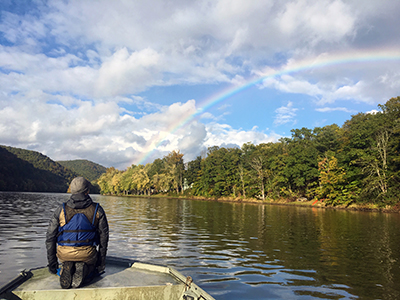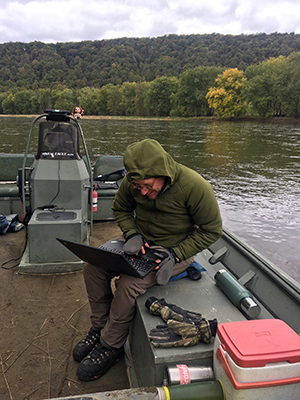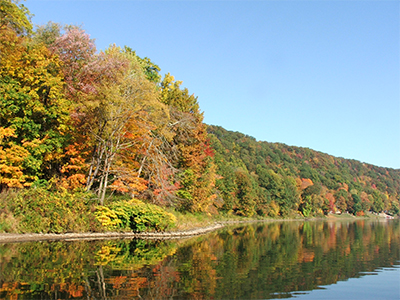
The 325-mile Allegheny River traverses landscapes of forest valleys, farmland, towns and cities from its beginning in Potter County until it joins the Monongahela River in Pittsburgh. One of the most spectacular parts of the Allegheny River for recreation and nature watching is a free-flowing, 125-mile stretch between the Kinzua Dam in Warren County and Brady’s Bend in Armstrong County.
The Western Pennsylvania Conservancy partnered with other experts Oct. 22-25, 2018, for a special project in this part of the Allegheny River near the Kinzua Dam in West Hickory, Pa. to help endangered mussels species. The Allegheny River has a large density of freshwater mussels, which have the ability to filter billions of gallons of water per day.

The U.S. Army Corps of Engineers release water from the dam, allowing WPC scientists to get a more accurate and closer look at the river bottom and its inhabitants. Conservancy staff used sonar and other mapping tools to measure and record the shape of the river bottom.
This depth-mapping method – called bathymetry – allows scientists to better understand and evaluate underwater conditions for fish and mussel habitat. Conservancy scientists undertook a similar project in the lower Allegheny in 2006 and created a topographic map for nearly 75 river miles from near Parker, Pa. to the turnpike bridge in Harmarville.
“This was a unique and important opportunity for all of us to gain a better understanding of the habitat in the Allegheny River. This is one of the most densely populated reaches for freshwater mussels in the Allegheny,” said Eric Chapman, director of aquatic science at WPC, of the most recent mapping near the Kinzua Dam.
This project was part of a multi-year joint effort by the U.S. Army Corps of Engineers and The Nature Conservancy to help manage flows from the dams along the Allegheny River to better mimic more natural river flows. Other project partners include the U.S. Fish and Wildlife Service and U.S. Forest Service.
The Western Pennsylvania Conservancy has been working in the Allegheny River and its watershed for decades. Beginning in the 1965, WPC commissioned a study to set criteria for land protection in the Allegheny River watershed. By 1981, nearly 9,000 acres, including 16 islands and key shoreline areas, had been acquired. Most of this land was adjacent to the Allegheny National Forest.

Other Allegheny River Conservation Highlights:
- WPC has protected nearly 100,000 acres in the Allegheny River watershed including its tributaries and 20,000 acres of islands, shorelines and valleys.
- From May 2012 to April 2016, 19,164 trees were planted along more than 54,000 feet of streambank in the Allegheny River Watershed, totaling nearly 85 acres.
- Over the last two years, the Conservancy was involved in the largest federally endangered mussel relocation project in U.S. history to undertake the tagging and transfer of 90,805 federally endangered mussels from the Allegheny to rivers in seven states and the Seneca Nation of Indians whose mussel populations were low or nearly nonexistent. More than 34,000 common mussel species were also transplanted to locations in the Clarion and Ohio rivers to help reestablish those populations.
- The Conservancy is active in the Allegheny Watershed Improvement Needs (WINS) Coalition, formed in 2007. This vital partnership of nonprofits, government agencies and volunteers protects and restores habitat in the watersheds of the Allegheny National Forest.
- Large-scale tree plantings have been conducted in neighborhoods that border the Allegheny River, downtown Pittsburgh and along the Three Rivers Heritage Trail to Point State Park, all of which positively impact that quality of the watershed.
- The Conservancy has completed more than 90 Unassessed Water surveys in the Allegheny National Forest to find previously unknown populations of native brook trout, and conducted freshwater mussel surveys at 54 sites in the Allegheny River and its tributaries, including exploration of Kinzua Lake. This research provides data for many restoration projects with the U.S. Forest Service and others.
